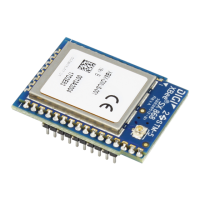Networking methods Directed Broadcast/Repeater mode
XBee® SX 868 RF Module User Guide
86
Directed Broadcast/Repeater mode
In this delivery method, the device sends all outgoing transmissions as broadcasts. Unicast messages
are sent as broadcasts, but are addressed to a specific receiver. Only the specified device will emit the
received frame out of the serial port.
n
Directed broadcast over hops is only available when operating at the 80k RF data rate (BR = 1).
The 10k data rate will only address adjacent devices and does not repeat received packets.
n
By default the CE parameter is set to route all broadcasts. As such, all nodes that receive a
repeated packet will repeat it. If you change the CE parameter, you can limit which nodes
repeat packets, which helps dense networks from becoming overly congested while packets
are being repeated.
Point to Point/Multipoint mode
In this mode, there is a permanent link between two endpoints. Switched point-to-point topologies
are the basic model of conventional telephony. The value of a permanent point-to-point network is
unimpeded communications between the two endpoints. The value of an on-demand point-to-point
connection is proportional to the number of potential pairs of subscribers.
Permanent (dedicated)
One of the variations of point-to-point topology is a point-to-point communications channel that
appears, to the user, to be permanently associated with the two endpoints. Within many switched
telecommunications systems, it is possible to establish a permanent circuit. One example might be a
telephone in the lobby of a public building that is programmed to ring only the number of a telephone
dispatcher. “Nailing down” a switched connection saves the cost of running a physical circuit between
the two points. The resources in such a connection can be released when it is no longer needed.
Switched
Using circuit-switching or packet-switching technologies, you can set up a point-to-point circuit
dynamically and dropped when no longer needed.
DigiMesh networking
A mesh network is a topology in which each node in the network is connected to other nodes around
it. Each node cooperates in transmitting information. Mesh networking provides these important
benefits:
n
Routing. With this technique, the message is propagated along a path by hopping from node
to node until it reaches its final destination.
n
Ad-hoc network creation. This is an automated process that creates an entire network of
nodes on the fly, without any human intervention.
n
Self-healing. This process automatically figures out if one or more nodes on the network is
missing and reconfigures the network to repair any broken routes.
n
Peer-to-peer architecture. No hierarchy and no parent-child relationships are needed.
n
Quiet protocol. Routing overhead will be reduced by using a reactive protocol similar to AODV.

